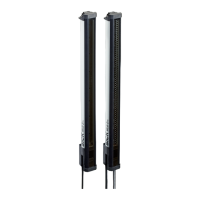First, configure a zone in the beam window. In the example, beams 13 and 14 are com‐
bined into one zone. Next, assign an application and a zone to the desired output (see
"“Zone measuring” function", page 85).
Context menu – Using beams for object recognition
b
Select several beams (by pressing the Ctrl key).
b
In the context menu, select the command Use marked beams for switching output > as
object to recognize > assign to Qx
Figure 53: Using beams for object recognition
In the example, beams 10 and 11 and beams 14 and 15 are assigned to output Q1. If
these beams are blocked, output Q1 switches. The object size may vary positively or
negatively by the number of tolerance beams set (see "Object recognition", page 69).
Context menu – Using beams for height classification
b
Select a beam.
b
In the context menu, select the command Use marked beams for switching output > as
maximum height > assign to Qx.
Figure 54: Using beams for height classification
In the example, beam 12 is assigned to output Q1. If the last beam blocked is greater
than or equal to beam 12, output Q1 switches.
Context menu – Using beams to classify the object position
b
Select a beam.
b
In the context menu, select the command Use marked beams for switching output > as
center of object > assign to Qx.
7 CONFIGURATION WITH SOPAS ET
60
O P E R A T I N G I N S T R U C T I O N S | MLG-2 Pro 8017460.ZIK1/2017-02-13 | SICK
Subject to change without notice

